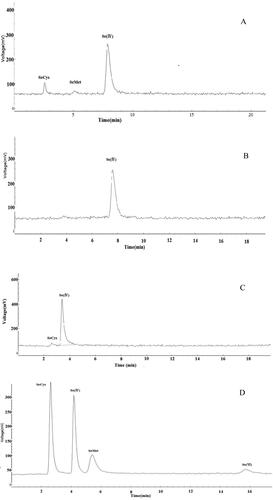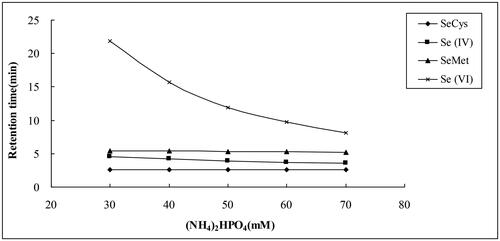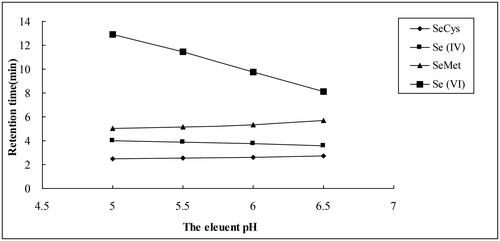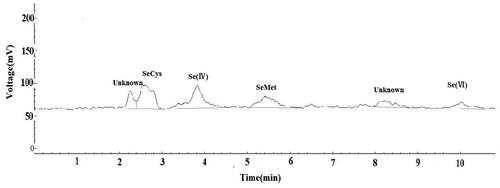Figures & data
Table 1. Optimized operational conditions for HG-AFS.
Figure 1. Typical chromatogram obtained when using eluent containing 40 mmol L−1 NH4H2PO4 pH 4.48 (A), 40 mmol L−1 NH4Ac at pH 6.94 (B), 40 mmol L−1 NH4NO3 at pH 5.18 (C) and 40 mmol L−1 (NH4)2HPO4 at pH 6.00 (D). The mixed standard concentration of SeCys 118.2 μg L−1, Se(IV)85.8 μg L−1, SeMet 88.7 μg L−1, Se(VI) 83.0 μg L−1 determined by HPLC-HG-UV-AFS. The optimized operational conditions for HG-AFS as described in . Note: HPLC, high-performance liquid chromatography; HG-AFS, hydride generation atomic fluorescence spectrometry.

Figure 2. Retention times of four Se species as a function of the concentration of mobile phase containing 30–70 mmol L−1 (NH4)2HPO4 at pH 6.00. Other HG-AFS conditions were as described in . Note: Each experiment was repeated four times.

Figure 3. Retention times of four Se species as a function of the pH of the mobile phase containing 60 mmol L−1 (NH4)2HPO4. Other HG-AFS conditions were as described in . Note: Each experiment was repeated four times.

Table 2. Standard curves of four Se species (n = 3).
Figure 4. Typical chromatogram of the flue-cured tobacco roots treated with 22.2 mg kg−1 Se obtained when using an eluent containing 60 mmol L−1 (NH4)2HPO4 at pH 6.00. The optimized operational conditions for HG-AFS as described in . The retention times of the unknown species were 135 s (2’15") and 492 s (8’12") in . The unknown species were not identified due to the lack of Se standards in this method.

Table 3. Se species in the leaves and roots of flue-cured tobacco after applying the proposed extraction procedure and measurement with UG-AFS.
Data availability
All data that support the findings reported in this study are available from the corresponding author upon reasonable request.
